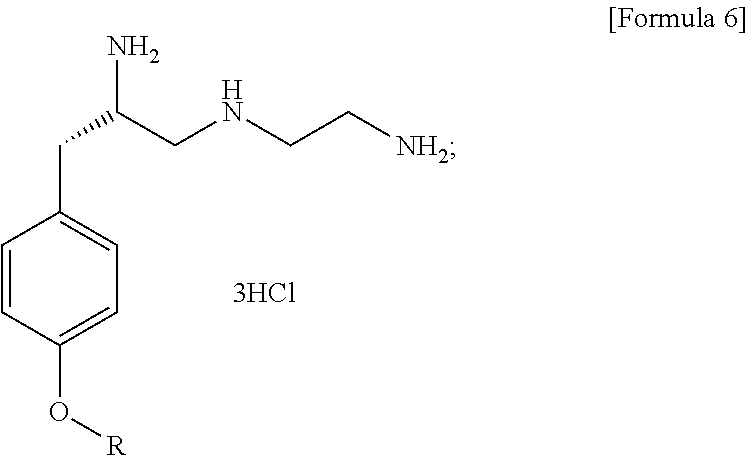Method for preparation of (s)-n1-(2-aminoethyl)-3-(4-alkoxyphenyl)propane-1,2-diamine trihydrochloride
a technology of diamine trihydrochloride and n-aminoethyl, which is applied in the preparation of carbamic acid derivatives, chemistry apparatus and processes, and organic chemistry, etc., can solve the problem of not disclosing a reference method for preparing (s), and achieve the effect of reasonable raw materials, efficient and economic production, and simple reaction process
- Summary
- Abstract
- Description
- Claims
- Application Information
AI Technical Summary
Benefits of technology
Problems solved by technology
Method used
Image
Examples
example 1
Preparation of (R)-1-chloro-3-(4-ethoxyphenyl)propane-2-ol
[0043]In a reactor substituted with a nitrogen atmosphere, magnesium (14.50 g, 596.84 mmol) was added to 600 mL of THF, and the mixture was stirred to dissolve. While maintaining the temperature at 20° C. to 30° C., 4-bromophenetole (120.0 g, 596.84 mmol) was slowly added. After the completion of the addition, the temperature was raised to 60° C., and the mixture was stirred for 2 hours, followed by cooling to -5° C., adding copper iodide (0.76 g, 2.98 mmol), and stirring the mixture for an additional 30 minutes. Thereafter, (R)-epichlorohydrin (49.70 g, 537.15 mmol) was slowly added, and the mixture was stirred at room temperature for 1 hour. After completion of the reaction, the temperature was reduced to 5° C., and aqueous hydrochloride acid (3 M, 600 mL) and isopropyl ether (360 mL) were added to separate into layers. The organic layer was washed twice with a 10% aqueous EDTA solution (480 mL) and a 20% aqueous sodium chl...
example 2
Preparation of (R)-1-azido-3-(4-ethoxyphenyl)propane-2-ol
[0045](R)-1-Chloro-3-(4-ethoxyphenyl)propane-2-ol (115.33 g, 537.15 mmol) prepared in Example 1 above was added to 580 mL of dimethylformamide, and the mixture was stirred to dissolve, followed by addition of sodium iodide (8.05 g, 53.72 mmol) and sodium azide (69.85 g, 1074.39 mmol) thereto. The temperature inside the reactor was raised to 85° C., and the mixture was stirred for 16 hours. After the completion of the reaction, the mixture was cooled to room temperature, and 580 mL of purified water and 580 mL of isopropyl ether were added to separate into layers. And then, the obtained water layer was further extracted with isopropyl ether (190 mL) twice. The recovered organic layer was washed with aqueous hydrochloric acid (1 M, 580 mL), a 5% aqueous sodium bicarbonate solution (580 mL), and a 10% aqueous sodium chloride solution (580 mL), dried over sodium sulfate, and the mixture was filtered. The filtrate was concentrated ...
example 3
Preparation of (S)-tert-butyl 2-(4-ethyoxybenzyl)aziridine-1-carboxylate
[0047]In a reactor substituted with a nitrogen atmosphere, (R)-1-azido-3-(4-ethoxyphenyl)propane-2-ol (113.0 g, 510.71 mmol) prepared in Example 2 was added to acetonitrile (AN, 1130 mL), and the mixture was stirred, followed by addition of triphenylphosphine (PPh3, 120.56 g, 459.64 mmol), stirring at room temperature for 2 hours, and refluxing for 4 hours. After completion of the reaction, the mixture was cooled to 20° C., and 4-dimethylaminopyridine (DMAP, 0.62 g, 122.17 mmol) and di-tert-butyl dicarbonate ((Boc)2O, 100.32 g, 459.64 mmol) were slowly added, and the mixture was stirred for 30 minutes. After adding hydrogen peroxide (11.60 g, 102.14 mmol) to the mixture and stirring it for an additional 30 minutes, the resultant was concentrated, and the acetonitrile was removed. The obtained concentrate was charged with heptane (1130 mL), and the mixture was stirred at 20° C. to 25° C. for 30 minutes, followed ...
PUM
| Property | Measurement | Unit |
|---|---|---|
| temperature | aaaaa | aaaaa |
| temperature | aaaaa | aaaaa |
| temperature | aaaaa | aaaaa |
Abstract
Description
Claims
Application Information
 Login to View More
Login to View More - R&D
- Intellectual Property
- Life Sciences
- Materials
- Tech Scout
- Unparalleled Data Quality
- Higher Quality Content
- 60% Fewer Hallucinations
Browse by: Latest US Patents, China's latest patents, Technical Efficacy Thesaurus, Application Domain, Technology Topic, Popular Technical Reports.
© 2025 PatSnap. All rights reserved.Legal|Privacy policy|Modern Slavery Act Transparency Statement|Sitemap|About US| Contact US: help@patsnap.com



